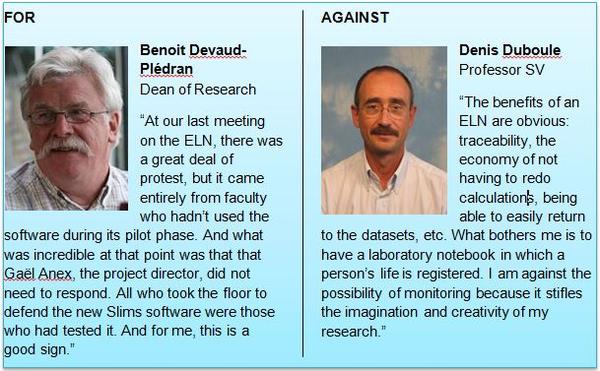The Challenges of the (Electronic?) Lab Notebook

© 2014 EPFL
Over the past few decades, the daily routines of a researcher have changed dramatically. With the arrival of new technology, the computer further infiltrates all levels of work. All? Yes – even the good old laboratory notebook may soon be replaced by a digital tablet.
Many cannot imagine the future of research without an electronic laboratory notebook (ELN). Others point to the growing threat of hidden interference from supervisory authorities. And some simply fear working more or do not want to change their working habits. So what is the future of the traditional paper laboratory notebook in the midst of this computerized ocean?
Technological developments in recent decades force the comparison, and the question arises more frequently now that a pilot phase has been conducted among several laboratories of the School of Life Sciences. Over the course of several months researchers had the opportunity to test a software for the daily management of their data, and more than a dozen laboratories have chosen to continue with the electronic version of the notebook. Gaël Anex, the project manager, says the bottom line is clear: “The transition from paper to digital is difficult but possible, and it’s ultimately beneficial to the continuity of knowledge developed during research.”
The project entitled, “Data Management Research,” was initiated in 2012 by the CSNI under the leadership of Didier Trono, SV Dean at the time, and Benedict Deveaud-Plédran, Dean of Research. “The goal was to develop a tool for all EPFL researchers that improves their lives and enables the school to align with European standards for guaranteeing data retention at the same time.” Gaël Anex of CSIN then met with researchers from 27 SV laboratories to understand their precise needs, identify the software best suited to respond to them, and to deploy volunteers.
Advantages and disadvantages
The company Genohm SA (a Science Park startup) developed the software—it combines the tools of an ELN with those of a LIMS (Laboratory Information Management System*). It makes it possible to organize information for research projects – experiences, samples, data, analyses, and results – and ensure the continuity of knowledge and techniques in laboratories. In addition, it can be accessed remotely and facilitates the writing of scientific reports, collaboration, and sharing data within the scientific community.
On the other hand, the ELN creates misgivings because it standardizes and unifies the documentation process of research. For some researchers, this goes against an essential ingredient: creativity. The working methods and stringent testing of the electronic tool were adapted to find a compromise for a standardized organization of information that is flexible and sufficiently accommodating such that most researchers find it satisfactory enough to abandon the paper notebook. On the practical level, it is impossible to have a computer on a laboratory bench, which means frequent trips back to a desk. On this last point, however, Gaël Anex explains: “There is now the ability to do all this on an iPad. This tool undoubtedly facilitates the daily lives of bench researchers. In addition, it is fun and intuitive.”
Current challenges
The issue of electronic laboratory notebooks has assumed a growing importance over the last few years because it is rooted at the heart of research. The EPFL Direction considers academic freedom paramount, and a researcher must not be forced to change working methods. However, all research is also defined by the era in which it occurs. Twenty-first century academia is characterized by active collaboration between research institutions, standardized controls, security and data traceability – not to mention the ever-increasing demands of the Grants office and specialized journals. These variables should not be neglected by those who want to stay in the international arena of scientific research.
Perspectives
